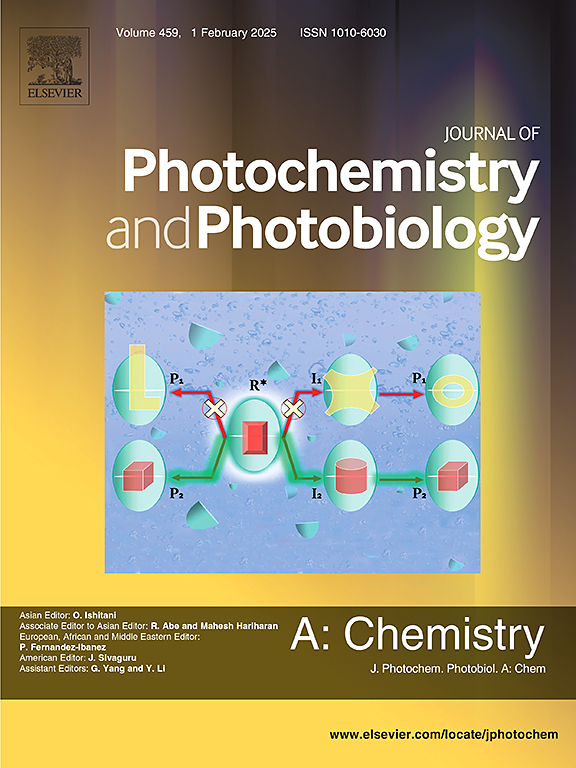通过原子层沉积构建三维CNTs/TiO2自支撑杂化织物,增强可见光催化活性
IF 4.1
3区 化学
Q2 CHEMISTRY, PHYSICAL
Journal of Photochemistry and Photobiology A-chemistry
Pub Date : 2025-07-10
DOI:10.1016/j.jphotochem.2025.116617
引用次数: 0
摘要
由合成染料引起的污染是一个全球性的挑战,需要立即和有效的解决方案。光催化为解决这一难题提供了有效的解决方案,而碳纳米管(CNTs)是开发先进复合光催化剂的一种很有前途的材料。然而,其明显的疏水特性极大地阻碍了其在水基环境中的适用性。在本研究中,采用原子层沉积(ALD)的方法,通过二氧化钛(TiO2)的沉积对独立式碳纳米管衬底进行了修饰。通过控制ALD沉积和随后的煅烧条件,研究了碳纳米管织物中氧化物的负载。研究了纳米碳纳米管织物的形态特征、晶体结构、润湿性和光催化性能。一方面通过TiO2的ALD提高了碳纳米管织物的亲水性,另一方面功能化后的织物表现出优异的光催化降解性能。与原始碳纳米管织物相比,tio2 -碳纳米管复合织物具有优异的光催化降解性能和稳定的可重复使用性。煅烧后,CNTs与锐钛矿TiO2的结合显著提高了电子传递效率,显著降低了光生电子与空穴之间发生复合的概率。本文章由计算机程序翻译,如有差异,请以英文原文为准。

Three-dimensional CNTs/TiO2 self-supporting hybrid fabrics constructed via atomic layer deposition for visible-light-enhanced catalytic activity
The contamination caused by synthetic dyes represents a global challenge that requires immediate and effective solutions. Photocatalysis provides an effective solution to this challenge, and carbon nanotubes (CNTs) represent a promising material for the development of advanced composite photocatalysts. However, the pronounced hydrophobic characteristics significantly hinder its applicability in water-based environments. In this research, the freestanding CNT substrates were modified via the deposition of titanium dioxide (TiO2) using atomic layer deposition (ALD). The loadings of oxide in CNT fabrics were examined by controlling ALD deposition and subsequent calcination conditions. The morphological characteristics, crystalline structure, wettability, and photocatalytic performance of the deposited CNT fabrics were also systematically investigated in detail. The hydrophilicity of CNT fabrics is promoted via ALD of TiO2 on one hand, and the functionalized fabrics exhibit excellent photocatalytic degradation performance on the other. Compared with pristine CNT fabric, the TiO2-CNT composite fabric exhibits excellent photocatalytic degradation performance and stable reusability. After calcination, the integration of CNTs with anatase TiO2 significantly enhances electron transfer efficiency and markedly reduces the recombination probability occurring between photogenerated electrons and holes.
求助全文
通过发布文献求助,成功后即可免费获取论文全文。
去求助
来源期刊
CiteScore
7.90
自引率
7.00%
发文量
580
审稿时长
48 days
期刊介绍:
JPPA publishes the results of fundamental studies on all aspects of chemical phenomena induced by interactions between light and molecules/matter of all kinds.
All systems capable of being described at the molecular or integrated multimolecular level are appropriate for the journal. This includes all molecular chemical species as well as biomolecular, supramolecular, polymer and other macromolecular systems, as well as solid state photochemistry. In addition, the journal publishes studies of semiconductor and other photoactive organic and inorganic materials, photocatalysis (organic, inorganic, supramolecular and superconductor).
The scope includes condensed and gas phase photochemistry, as well as synchrotron radiation chemistry. A broad range of processes and techniques in photochemistry are covered such as light induced energy, electron and proton transfer; nonlinear photochemical behavior; mechanistic investigation of photochemical reactions and identification of the products of photochemical reactions; quantum yield determinations and measurements of rate constants for primary and secondary photochemical processes; steady-state and time-resolved emission, ultrafast spectroscopic methods, single molecule spectroscopy, time resolved X-ray diffraction, luminescence microscopy, and scattering spectroscopy applied to photochemistry. Papers in emerging and applied areas such as luminescent sensors, electroluminescence, solar energy conversion, atmospheric photochemistry, environmental remediation, and related photocatalytic chemistry are also welcome.

 求助内容:
求助内容: 应助结果提醒方式:
应助结果提醒方式:


